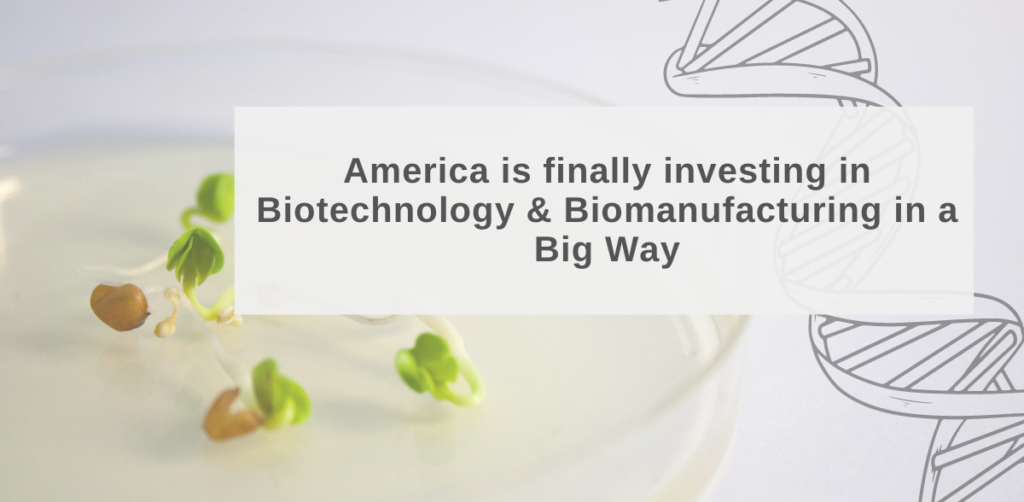Summary:
On September 12, 2022, President Biden issued an Executive Order, titled ‘Advancing Biotechnology and Biomanufacturing Innovation for a Sustainable, Safe, and Secure American Bioeconomy.’ The Executive Order outlined approximately $2 billion in funding to support the National Biotechnology and Biomanufacturing Initiative (or, NBBI). This new legislation is spurring conversation in biotechnology and beyond – to the agriculture and food industries. With its emphasis on funding basic ‘research’ the impact of this order is already being felt, but it won’t be fully realized for several years. In this article we will discuss the new order, what it lays out, and what this means for America’s place in the biotech and biomanufacturing fields.
How much impact can an Executive Order have? The biotechnology and biomanufacturing sectors are about to find out. In September, President Biden issued an Executive Order to build on and expand currently biotech-promoting policies (Biden, 2022). While the Obama and Trump Administrations worked to modernize the Regulation of Biotechnology (first issued in 1986), Biden’s actions differ from previous Administrations in its scope (Wiley, 2022). As part of his Executive Order, Biden outlined approximately $2 billion in funding to be given to the National Biotechnology and Biomanufacturing Initiative (or, NBBI) (Biden, 2022).This order is doubling down on Biden’s previous investment in Biomedicine in America: the new sub-agency within Department of Health and Human Services, known as the Advanced Research Projects Agency for Health (ARPA-H), which was authorized in March 2022. For 2022 Congress allocated $1 billion to the ARPA-H, but President Biden proposed raising this number for the upcoming 2023 fiscal year to $5 billion (Kornack, 2022).
“Although the power of these technologies is most vivid at the moment in the context of human health, biotechnology and biomanufacturing can also be used to achieve our climate and energy goals, improve food security and sustainability, secure our supply chains, and grow the economy across all of America.”
– President Biden
Taken together, Biden’s Administration is sending a strong message that they believe it is time for America to take the stage on the bioeconomy. In fact, Biden’s Order is being compared to President John F. Kennedy’s dramatic expansion of the U.S. space program. Unsurprisingly, Biden’s actions have peaked the interest of many sectors, For instance, researchers in the Engineered Biomaterials Research Laboratory (EBRL) at University of Vermont, see this as a call to action for the production of cultivated meat, which could act both as a way to provide food security for our meat-consuming nation, and, as a form of regenerative medicine, creating a flexible wound sealant (Defibaugh, 2022).
“as Earth’s population continues to grow—to 9 billion people by 2040, according to some estimates—we will need 50% more food (…) cultivated meat is trying to create additional ways to provide nutritious food for the people of the world”
– Dr. Rachael Floreani, Director of the EBRL
How is this Investment Allocated?
- The Department of Health and Human Services: Investing $40 million to “to expand the role of biomanufacturing for active pharmaceutical ingredients (APIs), antibiotics, and the key starting materials needed to produce essential medications and respond to pandemics.”
- The Department of Defense: Investing $1 billion over five years in bioindustrial domestic manufacturing infrastructure, $270 million over five years to translate research into products and “to support the advanced development of bio-based materials for defense supply chains,” and $200 million in biosecurity and cybersecurity.
- The Department of Agriculture: Investing $500 million “to support independent, innovative, and sustainable American fertilizer production to supply American farmers” with the help of biotechnology and biomanufacturing advances.
- The Department of Energy: Investing $100 million for R&D for conversion of biomass to fuels and chemicals, $60 million “to de-risk the scale up of biotechnology and biomanufacturing that will lead to commercialization of biorefineries,” and $20 million for a “bioassurance program” to advance biosecurity.
- The Department of Commerce: Investing $14 million next year on “biotechnology research programs to develop measurement technologies, standards, and data for the U.S. bioeconomy.”
How will this Impact America’s Place in the Bioeconomy?
While there is substantial biotech and biomanufacturing research currently being conducted in America, it is important to notice what level of research these experiments are. Due to the low return on investment of basic research, the vast majority of privately backed experiments are developmental or applied studies. Although these studies are attractive as they can produce new products and therapies quickly, basic research provides fundamental insights that benefits research across the board.
“the U.S. business sector funds 85% of experimental development and 54% of applied research, but it only funds a mere 29% of basic research.”
– NCSES
The new Executive Order, and subsequent investment in America’s bioeconomy is encouraging because as part of this order President Biden placed emphasis on R&D funding which can help fill the gap of available funding for basic research (NCSES, 2020).
Furthermore, part of Biden’s executive order includes the push to have the Department of Commerce form a lexicon for the bioeconomy which will enable clear communication between stakeholders and members of the public.
Conclusion
With the American government’s new emphasis on biotechnology and biomanufacturing there will be increased available funding, but perhaps even more impactful will be the promotion of industry standards in policy, decision-making, and R&D investment which will set America up to collaborate with other countries. Undoubtedly, these efforts will accelerate biotechnology and biomanufacturing, and produce new discoveries and therapeutics that are currently unforeseeable.



